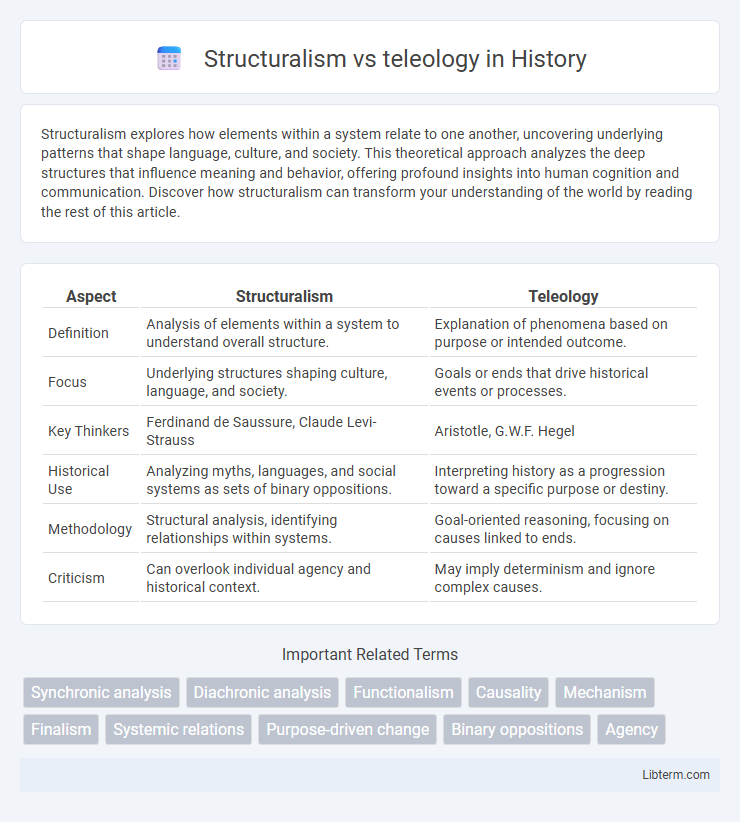Structuralism explores how elements within a system relate to one another, uncovering underlying patterns that shape language, culture, and society. This theoretical approach analyzes the deep structures that influence meaning and behavior, offering profound insights into human cognition and communication. Discover how structuralism can transform your understanding of the world by reading the rest of this article.
Table of Comparison
| Aspect | Structuralism | Teleology |
|---|---|---|
| Definition | Analysis of elements within a system to understand overall structure. | Explanation of phenomena based on purpose or intended outcome. |
| Focus | Underlying structures shaping culture, language, and society. | Goals or ends that drive historical events or processes. |
| Key Thinkers | Ferdinand de Saussure, Claude Levi-Strauss | Aristotle, G.W.F. Hegel |
| Historical Use | Analyzing myths, languages, and social systems as sets of binary oppositions. | Interpreting history as a progression toward a specific purpose or destiny. |
| Methodology | Structural analysis, identifying relationships within systems. | Goal-oriented reasoning, focusing on causes linked to ends. |
| Criticism | Can overlook individual agency and historical context. | May imply determinism and ignore complex causes. |
Introduction to Structuralism and Teleology
Structuralism explores human culture and cognition by analyzing underlying systems and relationships, emphasizing how components interact within a whole. Teleology studies phenomena based on purpose or goal-directedness, interpreting events and objects according to their end goals or functions. These frameworks offer contrasting approaches: Structuralism prioritizes systemic structures, while teleology centers on intentional outcomes.
Historical Background of Structuralism
Structuralism emerged in the early 20th century as a response to existential and phenomenological approaches, rooted in the works of Ferdinand de Saussure and later developed by scholars like Claude Levi-Strauss in anthropology and Roland Barthes in literary theory. It emphasizes the underlying structures that shape culture, language, and human thought, diverging from teleology's focus on purposeful and goal-directed processes. The historical background of Structuralism is marked by its interdisciplinary application, seeking to analyze systems of relationships rather than linear, outcome-driven explanations.
Origins and Development of Teleology
Teleology traces back to Aristotle's philosophy, emphasizing purposeful design and intrinsic goals within natural processes. Its development evolved through medieval scholasticism, which integrated teleological explanations with theological frameworks, and later influenced Enlightenment thinkers who debated goal-directedness in nature. Modern teleology contrasts sharply with structuralism, which analyzes systems based on internal relationships rather than intentional ends.
Core Principles of Structuralism
Structuralism centers on analyzing systems by examining relationships and interdependencies among components, emphasizing underlying patterns and structures that shape phenomena. It prioritizes synchronic analysis, studying elements within a system at a given moment rather than their historical development. This approach contrasts with teleology, which focuses on purpose and goal-directed processes, highlighting how outcomes influence the understanding of structures.
Central Tenets of Teleology
Teleology centers on the idea that natural phenomena and human actions are directed toward purposeful ends or goals, emphasizing causality based on future outcomes rather than solely past causes. It posits that objects and processes possess inherent purposes or functions, guiding their form and behavior in a goal-oriented manner. This approach contrasts with structuralism, which analyzes systems through their underlying structures without attributing purposeful direction or final causes.
Structuralism vs Teleology: Key Differences
Structuralism analyzes social phenomena by identifying underlying systems and relationships that shape behavior and meaning, emphasizing patterns and structures over individual purposes. Teleology centers on the purpose or end goals of phenomena, interpreting actions and events as directed toward specific outcomes or functions. The key difference lies in Structuralism's focus on the impersonal frameworks that govern existence, contrasting with Teleology's emphasis on intentionality and goal-oriented explanation.
Major Thinkers and Influencers
Structuralism, primarily developed by Claude Levi-Strauss and Ferdinand de Saussure, analyzes cultural phenomena through underlying structures such as language, myths, and social systems, emphasizing the interrelationships that shape meaning. Teleology, rooted in Aristotle's philosophy and later influenced by thinkers like Thomas Aquinas and Hegel, explains phenomena by purpose or end goals, stressing final causes in nature and human behavior. While Levi-Strauss deconstructs meaning into relational systems, Aristotle's teleology insists on intrinsic purposes guiding development and function within the natural world.
Applications in Philosophy and Science
Structuralism emphasizes analyzing systems through underlying relationships and patterns, widely applied in linguistics, anthropology, and cognitive science to uncover deep structures governing phenomena. Teleology focuses on purpose-driven explanations, particularly influential in ethics, biology, and cosmology for interpreting biological functions and intentionality based on perceived goals or ends. Both approaches shape scientific theories and philosophical frameworks by offering contrasting lenses--structuralism prioritizes systemic organization, while teleology centers on goal-oriented processes.
Criticisms and Contemporary Debates
Structuralism faces criticism for its deterministic approach, often neglecting individual agency and historical context by emphasizing underlying structures over human intention. Teleology is challenged for assuming purposeful design in natural phenomena, which critics argue imposes anthropocentric bias and hinders scientific explanations based on empirical evidence. Contemporary debates revolve around integrating structuralist insights with teleological perspectives in fields like biology, philosophy, and sociology to better understand complex systems and purposive behavior without reducing one to the other.
Conclusion: Structuralism or Teleology?
Structuralism emphasizes underlying systems shaping phenomena, while teleology focuses on purposeful direction and final causes. Evaluating complex social or biological processes often reveals that neither perspective alone suffices; structuralism explains patterns and relations, whereas teleology accounts for goals and functions. Integrating both approaches offers a more comprehensive understanding of causality and meaning.
Structuralism Infographic

 libterm.com
libterm.com